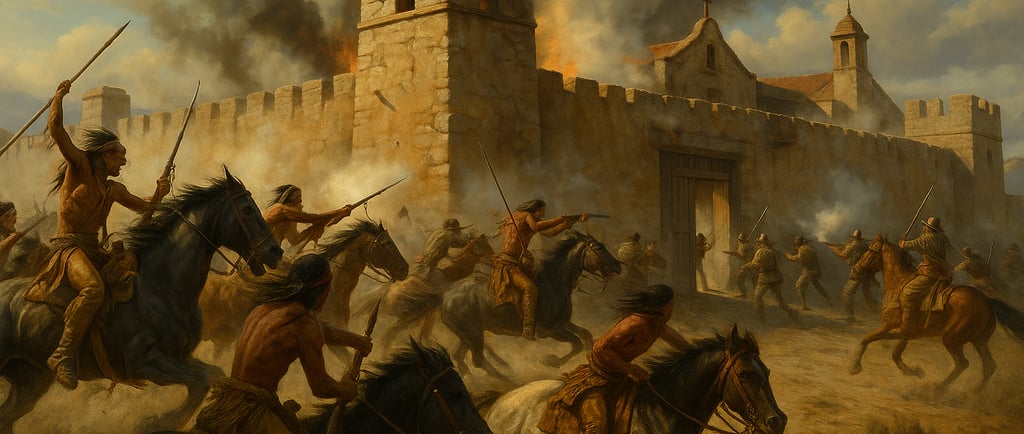Missions, Presidios & Comanche Thunder (1700–1821)
How Spain's ambitions met Native resistance—and how the thundering hooves of the Comanche reshaped Texas.


Spain’s Grand Design
By the 1700s, Spain was desperate to cement its claim to Texas. They knew paper maps wouldn’t protect them from French expansion—or from the powerful tribes that controlled the land. So they launched a bold campaign:
Build missions to convert, presidios to protect, and settlements to hold.
This trio—missions, presidios, and pueblos—would become Spain’s signature strategy. It wasn't just about saving souls. It was about building civilization.
The Mission Machine
Missionaries were sent to convert Native tribes to Christianity and Spanish customs. These missions doubled as schools, farms, and cultural re-education centers. Some of the most famous include:
Mission San Antonio de Padua (later San Antonio de Valero—better known today as The Alamo)
Mission Concepción, a remarkably preserved structure still standing in San Antonio
Mission San José, called the "Queen of the Missions"
Spain hoped that Native tribes would settle, farm, and adopt Spanish life under church supervision.
But not all Native peoples were willing to trade freedom for civilization.
Presidios and the Edge of Empire
Alongside the missions, presidios—small military forts—were built to defend the region. Soldiers fought French encroachment, Apache raids, and internal revolts.
But Texas was enormous, and Spain’s forces were stretched thin.
The presidios offered protection—but also symbolized control. For many Native peoples, they were a threat, not a shield.
Comanche Thunder
As Spain was building missions in the south and east, a new power emerged from the north: the Comanche.
Skilled horsemen, brilliant tacticians, and fierce warriors, the Comanche began pushing into Spanish Texas by the mid-1700s. Their raids were fast, brutal, and effective. They were unmatched on horseback—and Spain quickly learned the hard way.
They became known as the Lords of the Southern Plains, feared and respected. Their lightning raids across the Rio Grande and into San Antonio reshaped Spanish settlement patterns.
The Spanish even tried making peace with them—offering gifts, forging uneasy alliances—but the Comanche were unpredictable. They wanted horses, weapons, land—and independence.
A Fractured Frontier
By the late 1700s:
Some missions were abandoned due to raids and dwindling Native populations.
Others flourished, like San Antonio, which became a hub of Spanish life.
Tensions rose between settlers, soldiers, and Native tribes who refused to be ruled.
Meanwhile, whispers of revolution and change were stirring far to the south, in Mexico.
Spain’s hold on Texas was growing fragile.
The Road to Mexican Independence (1810–1821)
The Spanish Empire, weakened by internal decay and Napoleonic wars in Europe, began to crumble. By 1810, a revolutionary movement was born in Mexico.
In 1821, Spain officially lost control of Mexico—and with it, Texas.
After over a century of colonization, religion, and resistance, Spain’s long gamble in Texas ended. What came next would forever change the land.
Legacy of the Era
The names of towns like San Antonio, El Paso, and Laredo still echo Spain’s presence.
The mission ruins, some now UNESCO sites, attract millions of visitors each year.
The Comanche’s legacy of resistance and independence remains legendary.
Texas, by 1821, was no longer wild—but it wasn’t yet Texan.


